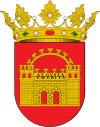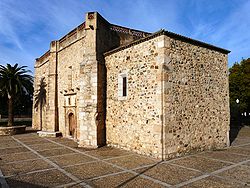- Mérida, Spain
-
Mérida — Municipality — 
Flag
Coat of armsLocation in Spain Coordinates: 38°54′N 6°20′W / 38.9°N 6.333°WCoordinates: 38°54′N 6°20′W / 38.9°N 6.333°W Country  Spain
SpainAutonomous community  Extremadura
ExtremaduraProvince Badajoz Comarca Mérida Valley Guadiana Judicial district Mérida Founded 25 BC Government – Mayor José Ángel Calle Gragera (2007) (PSOE) Area – Total 865.6 km2 (334.2 sq mi) Elevation 217 m (712 ft) Population (2010) – Total 57,127 – Density 66/km2 (170.9/sq mi) Demonym Emeritenses Time zone CET (UTC+1) – Summer (DST) CEST (UTC+2) Postal code 06800 Official language(s) Website Official website Mérida is the capital of the autonomous community of Extremadura, western central Spain. It has a population of 57,127 (2010). The Archaeological Ensemble of Mérida is a UNESCO World Heritage site since 1993.
Contents
Climate
Merida has a Mediterranean climate with Atlantic influences, due to the proximity of the Portuguese coast. The winters are mild, with minimum rarely below 0 °C (32 °F), and summers are hot with maximum temperatures occasionally exceeding 40 °C (104 °F).
As for precipitation, it normally measures between 450 and 500 mm annually . The months that record the most rainfall are November and December. Summers are dry, however, and it should be noted that in Merida, as in the rest of southern Spain, cycles of drought are common, ranging in duration from 2 to 5 years.
In autumn the climate is more changeable than in the rest of the year, and storms occur with some frequency, but are often dry.
Both humidity and winds are low. However, frequent occurrence of fog, especially in the central months of autumn and winter.
History
Historical populations Year Pop. ±% 1991 49,284 — 1996 51,830 +5.2% 2001 50,271 −3.0% 2006 53,915 +7.2% 2008 56,395 +4.6% 2010 57,127 +1.3% It was founded in the year 25 BC, with the name of Emerita Augusta (meaning the bachelors – discharged soldiers – of the army of Augustus, who founded the city; the name Mérida is an evolution of this) by order of Emperor Augustus, to protect a pass and a bridge over the Guadiana river. The city became the capital of Lusitania province, and one of the most important cities in the Roman empire. Mérida preserves more important ancient Roman monuments than any other city in Spain (including a triumphal arch of the age of Trajan).
After the fall of the Western Roman Empire, during the Visigothic period, the city maintained much of its splendor, especially under the 6th century domination of the bishops, when it was the capital of Hispania. In 713 it was conquered by the Muslim army under Musa bin Nusair, and became the capital of the cora of Mérida; the Arabs re-used most of the old Roman edifices and expanded them (such as in the case of the Alcazaba).
The city returned under Christians hands in 1230, when it was conquered by Alfonso IX of León, and subsequently became the seat of the priory of San Marcos de León of the Order of Santiago. A period of recovery started for Mérida after the unification of the Crowns of Aragon and Castile (15th century), thanks to the support of Alonso de Cárdenas, Grand Master of the Order. In 1720 the city became the capital of the Intendencia of Mérida.
In the 19th century, in the course of the Napoleonic invasion, numerous monuments of Mérida and of Extremadura were destroyed or damaged. Later the city became a railway hub and underwent massive industrialization.
Main sights
Among the remaining Roman monuments are:
- the Puente Romano, a bridge over the Guadiana River that is still used by pedestrians, and the longest of all existing Roman bridges.[1] Annexed is a fortification (the Alcazaba), built by the Muslim emir Abd ar-Rahman II in 835 on the Roman walls and Roman-Visigothic edifices in the area. The court houses Roman mosaics, while underground is a Visigothic cistern.
- remains of the Forum, including the Temple of Diana, and of the Roman Provincial Forum, including the Arch of Trajan
- remains of the Circus Maximus (1st century BC), one of the best preserved Roman circus buildings
- Acueducto de los Milagros (aqueduct of Miracles)
- patrician villa called the Villa Mitreo, with precious mosaic pavements
- Proserpina Dam and Cornalvo Dam, two Roman reservoirs still in use
- the Amphitheatre, and the Roman theatre, where a summer festival of Classical theater is presented, usually with versions of Greco-Roman classics or modern plays set in ancient times.
- Morerías archaeological site
- Museo Nacional de Arte Romano (designed by Rafael Moneo)
- Church of Santa Eulalia, dating to the 4th century but rebuilt in the 13th century. Its portico reuses parts of an ancient temple of Mars.
Other sights include:
- Cathedral of Saint Mary Major (13th-14th centuries)
- Renaissance Ajuntamento (Town Hall)
- Church of Santa Clara (17th century)
- Gothic church of Nuestra Señora de la Antigua (15th-16th centuries)
- Baroque church of Nuestra Señora del Carmen (18th century)
There are several notable buildings built recently, such as the Escuela de la Administración Pública (Public Administration College), the Consejerías y Asamblea de Junta de Extremadura (councils and parliament of Extremadura), the Agencía de la Vivienda de Extremadura (Housing Agency of Extremadura), the Biblioteca del Estado (State Library), the Palacio de Congresos y Exposiciones (auditorium), the Factoría de Ocio y Creación Joven (cultural and leisure center for youth), the Complejo Cultural Hernán Cortés (cultural center), the Ciudad Deportiva (sports city), the Universidad de Mérida (Mérida University), the Confederación Hidrografica del Guadiana (Guadiana Hydrographic Confederation designed by Rafael Moneo), the Puente Lusitania (Lusitania Bridge over the Guadiana River designed by Santiago Calatrava), the Palacio de Justicia (Justice Hall), etc.
International relations
Mérida is twinned with:
Sport
Mérida UD is the principal football team of the city.
See also
- Archaeological Ensemble of Mérida
Notes
- ^ O’Connor 1993, pp. 106–107
Sources
- O’Connor, Colin (1993), Roman Bridges, Cambridge University Press, pp. 106–107, ISBN ISBN 0-521-39326-4
External links
- Official website
- Roman Art National Museum
- Pictures of Roman Mérida
- Photos of Mérida: Roman monuments and other views of the city
- The Marvel of Mérida by The Guardian
Seville (Andalusia) · Zaragoza (Aragon) · Oviedo (Principality of Asturias) · Palma (Balearic Islands) · Vitoria-Gasteiz (Basque Country) · Santa Cruz de Tenerife & Las Palmas de Gran Canaria (Canary Islands) ·
Santander (Cantabria) · No capital (Castile and León) · Toledo (Castile-La Mancha) · Barcelona (Catalonia) · Mérida (Extremadura) · Santiago de Compostela (Galicia) · Logroño (La Rioja) · Madrid (Community of Madrid) ·
Murcia (Region of Murcia) · Pamplona (Navarre) · Valencia (Valencian Community) · Ceuta1 · Melilla11 Autonomous cities.Categories:- Mérida, Spain
- Roman aqueducts outside Rome
- Archaeological sites in Spain
- Municipalities in Badajoz
- 25 BC establishments
- Populated places in Badajoz
Wikimedia Foundation. 2010.




